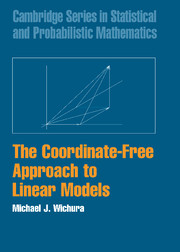Refine search
Actions for selected content:
2348 results in Statistical theory and methods
17 - On the So-Called “Huber Sandwich Estimator” and “Robust Standard Errors”
-
- Book:
- Statistical Models and Causal Inference
- Published online:
- 05 June 2012
- Print publication:
- 23 November 2009, pp 295-304
-
- Chapter
- Export citation
14 - The Grand Leap
-
-
- Book:
- Statistical Models and Causal Inference
- Published online:
- 05 June 2012
- Print publication:
- 23 November 2009, pp 243-254
-
- Chapter
- Export citation
10 - The Swine Flu Vaccine and Guillain-Barré Syndrome: A Case Study in Relative Risk and Specific Causation
-
-
- Book:
- Statistical Models and Causal Inference
- Published online:
- 05 June 2012
- Print publication:
- 23 November 2009, pp 151-168
-
- Chapter
- Export citation
1 - Issues in the Foundations of Statistics: Probability and Statistical Models
-
- Book:
- Statistical Models and Causal Inference
- Published online:
- 05 June 2012
- Print publication:
- 23 November 2009, pp 3-22
-
- Chapter
- Export citation
4 - Methods for Census 2000 and Statistical Adjustments
-
-
- Book:
- Statistical Models and Causal Inference
- Published online:
- 05 June 2012
- Print publication:
- 23 November 2009, pp 65-82
-
- Chapter
- Export citation
2 - Statistical Assumptions as Empirical Commitments
-
-
- Book:
- Statistical Models and Causal Inference
- Published online:
- 05 June 2012
- Print publication:
- 23 November 2009, pp 23-44
-
- Chapter
- Export citation
12 - On Regression Adjustments in Experiments with Several Treatments
-
- Book:
- Statistical Models and Causal Inference
- Published online:
- 05 June 2012
- Print publication:
- 23 November 2009, pp 195-218
-
- Chapter
- Export citation
18 - Endogeneity in Probit Response Models
-
-
- Book:
- Statistical Models and Causal Inference
- Published online:
- 05 June 2012
- Print publication:
- 23 November 2009, pp 305-322
-
- Chapter
- Export citation
References and Further Reading
-
- Book:
- Statistical Models and Causal Inference
- Published online:
- 05 June 2012
- Print publication:
- 23 November 2009, pp 357-392
-
- Chapter
- Export citation

The Coordinate-Free Approach to Linear Models
-
- Published online:
- 23 November 2009
- Print publication:
- 23 October 2006
Editors' Introduction: Inference and Shoe Leather
-
-
- Book:
- Statistical Models and Causal Inference
- Published online:
- 05 June 2012
- Print publication:
- 23 November 2009, pp xiii-xvi
-
- Chapter
- Export citation
Part I - Statistical Modeling: Foundations and Limitations
-
- Book:
- Statistical Models and Causal Inference
- Published online:
- 05 June 2012
- Print publication:
- 23 November 2009, pp 1-2
-
- Chapter
- Export citation
Part III - New Developments: Progress or Regress?
-
- Book:
- Statistical Models and Causal Inference
- Published online:
- 05 June 2012
- Print publication:
- 23 November 2009, pp 193-194
-
- Chapter
- Export citation
16 - Weighting Regressions by Propensity Scores
-
-
- Book:
- Statistical Models and Causal Inference
- Published online:
- 05 June 2012
- Print publication:
- 23 November 2009, pp 279-294
-
- Chapter
- Export citation
Part II - Studies in Political Science, Public Policy, and Epidemiology
-
- Book:
- Statistical Models and Causal Inference
- Published online:
- 05 June 2012
- Print publication:
- 23 November 2009, pp 63-64
-
- Chapter
- Export citation
5 - On “Solutions” to the Ecological Inference Problem
-
-
- Book:
- Statistical Models and Causal Inference
- Published online:
- 05 June 2012
- Print publication:
- 23 November 2009, pp 83-96
-
- Chapter
- Export citation
13 - Randomization Does Not Justify Logistic Regression
-
- Book:
- Statistical Models and Causal Inference
- Published online:
- 05 June 2012
- Print publication:
- 23 November 2009, pp 219-242
-
- Chapter
- Export citation
6 - Rejoinder to King
-
-
- Book:
- Statistical Models and Causal Inference
- Published online:
- 05 June 2012
- Print publication:
- 23 November 2009, pp 97-104
-
- Chapter
- Export citation
Preface
-
-
- Book:
- Statistical Models and Causal Inference
- Published online:
- 05 June 2012
- Print publication:
- 23 November 2009, pp xi-xii
-
- Chapter
- Export citation
Contents
-
- Book:
- Statistical Models and Causal Inference
- Published online:
- 05 June 2012
- Print publication:
- 23 November 2009, pp v-x
-
- Chapter
- Export citation
